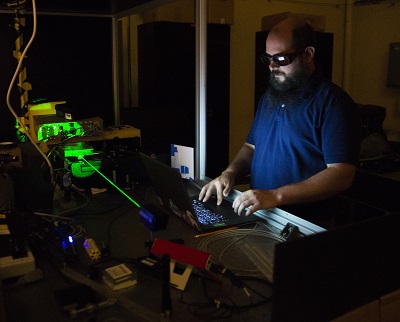Turbulence Profile Measurement with a Dynamically Ranged Rayleigh Beacon
Hosted By: Laser Systems Technical Group
13 August 2021 13:00 - 14:00
Eastern Time (US & Canada) (UTC -05:00)In this webinar hosted by the OSA Laser Systems Technical Group, Steven Zuraski from the U.S. Air Force Research Laboratory’s Sensors Directorate will discuss the Turbulence and Aerosol Research Dynamic Interrogation System, also known as TARDIS.
The effect of turbulence on a long range imaging system manifest as an image blur effect usually quantified by the phase distortions present in a system. The blurring effect is conceivably understood on the basis of measured strength of atmospheric turbulence profiled within the propagation volume. One method for obtaining a turbulence strength profile is by use of a dynamically ranged Rayleigh beacon system that exploits strategically varied beacon ranges along the propagation path, effectively deducing estimates of specific path segment contribution of the blurring aberrations affecting an optical imaging system.
The TARDIS system was designed to utilize this technique and a prototype has been constructed for testing. This webinar will summarize TARDIS, the tomographic turbulence estimation methodology, and analysis of initial proof of concept data collected.
Subject Matter Level: Intermediate - Assumes basic knowledge of the topic
What You Will Learn:
- A method for measuring the profile strength of atmospheric turbulence
- System considerations for building a dynamically ranged Rayleigh beacon
- Demonstrated data collection comparisons to other turbulence profile strength estimation methodologies
Who Should Attend:
- Those interested in methods to quantify atmospheric turbulence strength structures along a viewing path
About the Presenter: Steven Zuraski, U.S. Air Force Research Laboratory
 Steven M. Zuraski is a researcher at the Air Force Research Labs Sensors Directorate Multi-spectral Sensing Division at Wright-Patterson AFB, Ohio. Currently, he leads the EO Space Team within the division focusing on novel sensing approaches applied to Air Force and Space Force missions for space and from space. Steven Zuraski's research interests include EO remote sensing of the environment, atmospheric turbulence characterization, passive coherent sparse aperture imaging systems, and space-based sensor systems.
Steven M. Zuraski is a researcher at the Air Force Research Labs Sensors Directorate Multi-spectral Sensing Division at Wright-Patterson AFB, Ohio. Currently, he leads the EO Space Team within the division focusing on novel sensing approaches applied to Air Force and Space Force missions for space and from space. Steven Zuraski's research interests include EO remote sensing of the environment, atmospheric turbulence characterization, passive coherent sparse aperture imaging systems, and space-based sensor systems.
